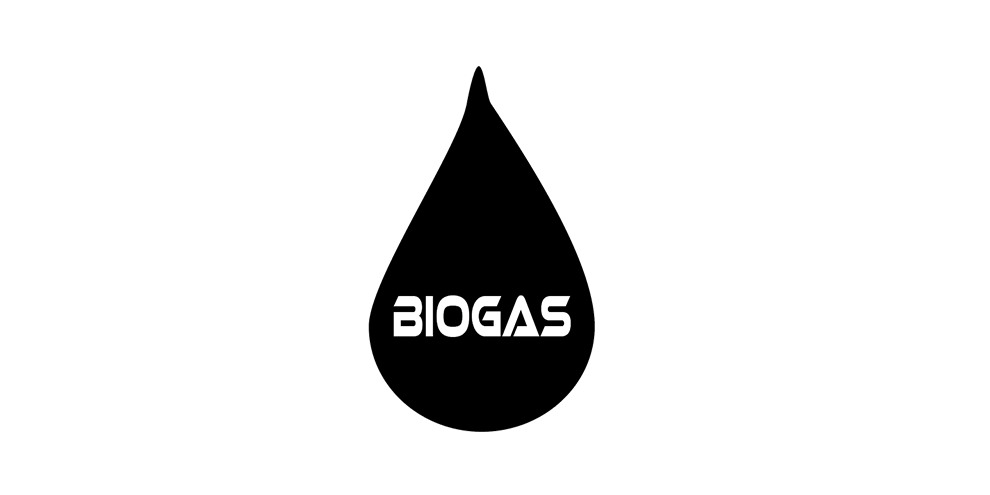Biogas fermentation is one of the most important component elements of Mass Circle in the natural world. Biogas is produced from the metabolized substance of anaerobic microorganism. In some of the ponds, manure pit and sewage, where are rich in organic wastes, we can see gas bubbled from the bottom. When ignited, the gas can spark the blue flame. Due to origination from the fen, we call it marsh gas or biogas. Methane bacteria are also found in some higher plants and animals, among which ruminant stomach of ruminates is a typical organ of biogas fermentation. Through a study of microbes in ruminant stomach, people obtained good knowledge concerning bacteria. There are plenty of biogas bacteria in the ruminant stomach where methane and carbon dioxide are formed. In the ruminant stomach of ahead of a milk cow, there are 100 liters of cellulose fermenting material, which by fermentation can give more than 200 liters of methane, breathing out during expiration.
Table 1. Origin & Nomenclature of Biogas
| Name classification | Nomenclature | |
| Original location | Fen or pond | Marsh gas, Sludge gas |
| Sewage | Culvert gas | |
| Manure pit | Manure gas | |
| Mining or Coal bed | Gas, coal gas, natural gas, casing head gas | |
| Investigator | Volta | Volta Combustible gas |
| Content | Methane | Methane gas |
| Materials | Biomass | Biogas |
| Producing route | Nature | Natural gas, biogas |
| Man-made | Biogas | |
| Country | India | Gobar gas, Cow manure gas |
History of Biogas
In 1630, biogas created from plants deposited in the swamp has been discovered by Van Helment, a doctor in Brussels, Belgium. This is one of 15 gases recorded by him that comes from the decomposed process of plants, and it also exists in intestinal gas. This is the first record about biogas in the development of biogas.
In 1667, Shirley also realized combustible gas in digestion, but he didn’t know what gas it was.
In 1776, Alessandro Volta, a physicist in Italy, discovered a combustible air in the swamp, and tried to analyze its compose. He also noticed that when one agitated the deposits at the bottom of the pond, there were a lot of combustible bubbles to give out from the pond surface.
In 1790, Priestley investigated this gas and wrote a paper combustible gas come from the decomposed process of plants. This paper confirmed Volta’s opinion.
In 1790, Dalton analyzed individual compose of combustible gas.
In 1806, William Henry obtained approximately 1 liter mixture gas from compost with water. This mixture gas containing about 60% of carbon dioxide, the rest is methane and a little bit of nitrogen gas. Later, he pointed out the combustible gas discovered by Volta is methane.
In 1808, Humphriey Davy, a chemist in England, began to investigate biogas fermentation from cattle manure with straw. He collected 0.3 liter of methane and 0.6 liter of carbon dioxide.
In 1866, Bechamp, a student of L. Pasteur, a scientist in France, suggested the methane formation is a microbial process, and then he called the process as Microzyma create.
In 1868, Bechamp also verified that methane comes from carbon compound through microorganisms. Furthermore, he obtained methane with using ethanol as only carbon source, carbonate as buffer mater, and sediments as inoculums.
In 1868, Reiset, a member of Royal Academy of Sciences, found that methane existed in a heap of cattle manure.
In 1875, Popoff, a scholar of Russia, discovered that methane fermentation is a complex microbial process. He and his research fellow first added materials containing cellulose to river mud for fermentation, resulting in the production of hydrogen and methane.
In 1875, Wouter Sluys, a farmer in Holland, first used methane for lighting. The methane gas comes from natural gas well, but digester. At that time, there were 60 or so farmer plants using this gas for a short time.
In 1882, Tappeiner carried out an experiment using plant mater as substrate and microbes lived in of ruminant’s intestine as inoculums. In this experiment, he set up three parallel groups. The first group added antiseptic agent for inhibiting the growth of bacteria but the reaction of the soluble enzyme, the second group killed bacteria and enzyme by boiling, the final group without any settlement. The result showed that only the final group could give out methane.
In 1883, Ulysse Gayon, a student of L. Pasteur, reported that biogas could be obtained from animal manure. In 1894, Paster put up this result to the French Academy of Sciences. He thought that biogas from manure digestion could be used for lighting and heating.
In the end of the 19th century, the first digester for wastewater treatment in France was set up by Louis Mouras. McCarty suggested that the year be the beginning and Mouras be the first founder for artificial anaerobic wastewater treatment.
In 1889, W. D. Scott-Moncrief built a set of equipment with the same principle as an anaerobic filter to remove out a great deal of suspending solid in water.
In 1894, A. N. Talbot designed a tank with the same as Mouras Automatic Scavenger.
In 1895, Donald Cameron, an English man, designed a septic tank. After a year, he built a septic tank in Exeter for treating demotic sewage, and the gas called sludge gas was used for street lighting.
In 1896, the British built the anaerobic digester for sewage treatment in Exeter. The sludge gas was used for street lighting.
In 1897, Matiunga Leper Asylum of Bombay, India built a biogas plant with using human being waste as feedstock for biogas production. The biogas was used for lighting, and then for a power source in 1907.
In 1899, Hary W. Clark, an American, brought forward that sludge in sewage should be removed rapidly. Based on this idea, in 1904, W. O. Travis, an English man, developed septic tank and first built a double layer sediment tank in Hampton, called Travis Tank.
In 1900, the Indian built biogas digester using human excrement as feedstock from a hospital for lepers in Matunga.
In 1901, Söhngen brought forward the concept of morphological characteristics of methane bacteria.
In 1914, K. Imhoff, a German scholar, developed Travis Tank into Imhoff Tank.
In 1916, Omelianskii isolated firstly a strain of methane bacteria, Methanobacterium omelianskii, not a pure strain identified.
In 1920, the Chinese Guo Rui Nature Gas Storage was published.
In 1925, Lack indicated that there were about 18 kinds of protistan, such as mastigot, infusorian and Amoeba in the biogas fermentation process, which had no effect on fermentation.
Between 1930 and 1934, Van Niel brought forward a new theory about methane generation from carbon dioxide reduction. The chemical formula was as followed:
4H2A=4A+8H
C02+8H=CH4+2H20
The total reaction was: 4H2A + C02=4A+CH4+2H20
In 1936, using sewage sludge cultivated by chemical medium, H. A. Barker obtained a kind of microorganism being suitable for the production of alcohol, propanol and butanol. At the same time, Heukelekian & Heinmann reported a technique for calculating the number of methane bacteria.
In 1948, Buswell & Sollo brought forward another theory about methane generation from methyl reduction. The chemical formula was:
14CH3COOH= 14CH4+ C02
CD3COOH+H20=CD3H+C02+H20
4CH30H+D20=3CH3D+C02
In 1950, R. E. Hungate established anaerobic technique which greatly contributed to initiate the study of methanogens.
In 1956, Baker testified the Buswell’s methyl reduction theory, which came out that methyl group of acetic acid was directly reduced to methane, while carboxyl group of acetic acid was converted to carbon dioxide. In the same year, Barker Hypothesis was found out, which was based on the combination with Van Niel’s carbon dioxide reduction theory and Buswell’s methyl reduction theory.
Also in 1956, Methanobacteriaceae was first summed up in one family, including 4 genera and 9 species by Barker.
From 50’s to 60’s in the 20th century, Cooke detected many molds during the fermentation process, among which 36 kinds of mold was isolated. He believed that the molds and yeasts involved the digestion process.
In 1965, the Hungate Technique was developed by Bryant.
In 1967, Bryant purified and identified Methanobacterium omelianskii, being a symbiont of Methmobacterium MOH and “S” organic strain, which was known as interspecies H2-transfer.
In 1967, O. W. Lawrence & P. L. McCarty proposed a three-step process: hydrolysis, hydrogen & acid production and methane production.
In 1969, Young & McCarty developed Anaerobic Filter (AF), which was suitable for the treatment of organic wastewater.
In 1970, the coenzyme M (CoM) was discovered in Methanobacterium MOH strain by McBride & R. S. Wolfe.
In 1971, S. Ghosh, an American anaerobic digestive expert, developed Two-phase Anaerobic Digester Process.
In 1972, the Factor 420 (F420) was discovered in Melhanobaclerium MOH strain by P. Cheeseman.
In 1974, Taylor & R. S. Wolfe have confirmed the CoM structure.
In 1974, in the Bergy’s Manual of Determinative Bacteriology (8th edition), methanogen was summed up in one family, including 3 genera and 9 species.
In 1974, Prof. G Lettinga, a professor in Department of Water Pollution Control, Agricultural University of Wageningen, developed Up-flow Anaerobic Sludge Bed (UASB), which has been applied since 1977.
In 1977, Archaebacteria, a brilliant concept, has been raised by Carl. R. Woese, who was ahead of the research team at Illinois University. These types of unusual bacteria are genealogically not prokaryotes or eukaryotes. This discovery means there are not two lines of descent but three: the true bacteria and the eukaryotes.
In 1978, R. P. Gunsalus & R. S. Wolfe separated to get the factor 430 (F430) from Methanobacterium thermoautotrophicum ΔH strain.
In 1978, Tornabene etc. have first researched lipids of methanogens.
In 1979, in the Bergy’s Manual of Determinative Bacteriology, methanogen was summed up in 3 orders, 4 families, 7 genera and 13 species.
In 1980, Smith pointed out that almost methanogen could make use of hydrogen & carbon dioxide as the base material to produce methane under pure cultivation, some of which could make use of methanoic acid.
In 1983, Thomm, Wood and Meile obtained plasmid from methanogen.
In 1983, Ferguson & Robert Mah proposed the metabolism mechanism of methane generation from a formate, which testified hydrogen production during the conversion from formate to methane.
In 1987, Bacterial Evolution, written by Carl R. Woese, was published in Microbio. Rev. (1987, 51: 221-271). This paper was a symbol of establishing the modern classification of bacteria.
In 1988, the International Society of Methanogenic Classification was founded.
In 1992, Carl R. Woese changed Archaebacteria to Archaeon, it means Archaeon is not bacteria, so he threw off postfix of “bacteria” in “Archaebacteria”.
In 1996, Complete Genome Sequence of the Methanogenic Archaeon, Methanococcus jannaschii was published by Bult C. J. et al. in Science, 1996, 273: 1058-1073.
In 2001, in the Bergy’s Manual of Systematic Bacteriology (2nd edition), methanogen was summed up in 5 orders, 10 families, 26 genera and 78 species.



